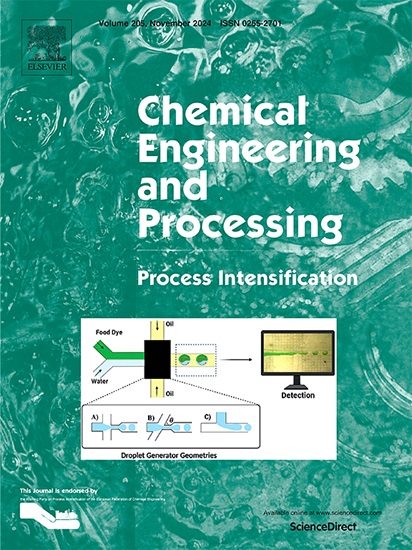Comparative analysis of flow behavior during the nanofluid Phase transition at serpentine microchannel bends
IF 3.8
3区 工程技术
Q3 ENERGY & FUELS
Chemical Engineering and Processing - Process Intensification
Pub Date : 2025-04-01
DOI:10.1016/j.cep.2025.110298
引用次数: 0
Abstract
With the growing demand for high-flux thermal management in electronics, understanding nanofluid flow dynamics during phase transitions in complex microchannel geometries remains a critical yet underexplored frontier. This study pioneers a comprehensive investigation into the flow characteristics of four nanofluids (Cu-water, Al2O3-water, Al-water, SiO2-water) before and after liquid-vapor phase transitions in serpentine microchannel bends, integrating the Mixture model with the RNG k-ε turbulence model. The novelty lies in the coupled analysis of multiphase flow, flow behavior and geometric effects during the phase transition of nanoparticles at different Reynolds numbers (100–400), volume fractions (0.1 %–1.3 %) and heat fluxes (50–80kW/m²). Key findings reveal that the change of heat flux density in pre-phase transition has little effect on pressure drop, but escalates with Reynolds number and volume fraction, with Cu-water exhibiting the highest growth rates (66.91 % and 42.96 %, respectively). Post-phase transition, despite lower absolute pressure drops, growth rates surpass pre-transition values (Cu-water: 67.16 % and 43.15 %), driven by vapor-induced turbulence and altered flow resistance mechanisms. These insights challenge the traditional single-phase cooling paradigm by quantifying how phase transitions modulate the behavior of nanofluids within serpentine microchannels, and can provide theoretical references for fields such as high-power electronics and aerospace thermal management.

蛇形微通道弯道纳米流体相变流动特性对比分析
随着电子领域对高通量热管理的需求不断增长,了解复杂微通道几何形状相变过程中的纳米流体流动动力学仍然是一个关键但尚未开发的前沿领域。本研究将混合模型与RNG k-ε湍流模型相结合,对四种纳米流体(cu -水、al2o3 -水、al -水、sio2 -水)在蛇纹微通道弯道液-气相变前后的流动特性进行了综合研究。新颖之处在于对不同雷诺数(100-400)、体积分数(0.1% - 1.3%)和热流密度(50-80kW /m²)下纳米颗粒相变过程中的多相流动、流动行为和几何效应进行了耦合分析。结果表明:相变前热流密度的变化对压降影响不大,但随着雷诺数和体积分数的增加而增大,其中Cu-water的增长率最高(分别为66.91%和42.96%);相变后,尽管绝对压降较低,但由于蒸汽引起的湍流和流动阻力机制的改变,增长率超过了相变前的值(铜水分别为67.16%和43.15%)。这些见解通过量化相变如何调节蛇形微通道内纳米流体的行为,挑战了传统的单相冷却范式,并可以为大功率电子和航空航天热管理等领域提供理论参考。
本文章由计算机程序翻译,如有差异,请以英文原文为准。
求助全文
约1分钟内获得全文
求助全文
来源期刊
CiteScore
7.80
自引率
9.30%
发文量
408
审稿时长
49 days
期刊介绍:
Chemical Engineering and Processing: Process Intensification is intended for practicing researchers in industry and academia, working in the field of Process Engineering and related to the subject of Process Intensification.Articles published in the Journal demonstrate how novel discoveries, developments and theories in the field of Process Engineering and in particular Process Intensification may be used for analysis and design of innovative equipment and processing methods with substantially improved sustainability, efficiency and environmental performance.

 求助内容:
求助内容: 应助结果提醒方式:
应助结果提醒方式:


